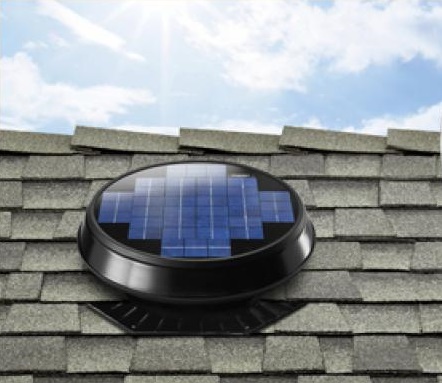Solar Powered Roof Vents
Home Builder Assist asked Sean to explain the benefits of solar powered roof vents over conventional turbines. You can talk to Sean in person by visiting Sola-Lite in San Antonio, Texas.
How It Works
Solar powered roof vents are used for ventilation. They draw hot air from your attic in order to push it outside. In a perfectly sealed environment, this would create a vacuum. But your attic isn’t sealed, so this negative pressure created in the attic draws in cooler air from the outside, usually through the soffits. This transfer of air is what keeps your attic closer to the outside temperature of the day, which can be dramatically different.
Summer Benefits
Imagine getting into your car after it has been sitting in the hot sun for a few hours. The sun beating down on the surface of the car super-heated the air inside. We all know if we had left our windows open, the temperature inside the car would have stayed much cooler. It would then only be as hot as the outside. The same thing happens in your attic. The air gets super-heated, but unfortunately, we don’t have windows to keep open. That is why having an attic fan is a great idea.
When temperatures in the attic rise much higher than the air outside, the insulation that you have tries to prevent that heat from penetrating down into your home. We want to minimize the work that the insulation is doing. If we can drop the temperature 20°, the R value of the insulation increases because it is not having to work as hard to prevent heat from transferring into the house.
Winter Benefits
If we keep the solar powered roof vent turned on all winter long, then we have the opposite effect. Now we have the heat inside the house. We are trying to stay warm and that heat will try to go through the ceiling on up into the attic space. If we are moving a lot of air up in the attic during cold months, then we are pulling colder air into our attic. In that case, we would want to have a thermostat controlled attic fan that wouldn’t turn on unless the temperature raised above a certain degree. That will minimize the heat loss.
Three Other Benefits
One: When we super-heat our attic it also super-heats our roof tiles which causes excess wear because of the cooling (shrinking) and heating (swelling). If we heat our roof tiles up hotter than they are rated, the shrinking and swelling over time will cause damage to the roof asphalt shingles. Let’s not even talk about the tar paper that can be underneath. I know that may sound a little over-exaggerated, but it really has that effect. Keeping an even temperature in the attic may very well extend the life of your roof material.
Two: As the attic is adjacent to the rooms below, a hot attic will prevent those rooms from cooling off naturally. This creates a higher demand on your air conditioning unit. So, reducing the temperature in the attic improves your energy efficiency by a reduction in air conditioning energy consumption. It also increases the life of your AC unit.
Three: Air movement in the attic also helps prevent moisture
from building up on the bottom of roofing materials and the rafters in the
summer. In the winter, the attic is cooler but still needs movement to prevent
ice dams from forming on the roof. If you turn off the solar powered roof vent in the winter, make sure your vents are operating properly so air can still
travel through the space.
A Word About Vents
The fresh air from the outside that the attic fan pulls in usually comes through the vents. These vents are fairly small with mesh screen openings placed along the home’s soffits. If the soffit vents get clogged or blocked by debris, this prevents a good clean transfer of air. Check your vents periodically for insulation build up as this will affect the fans smooth operation.
Solar Powered Roof Vents vs. Turbine vs. Ridge Vents
 |
For a clear and concise discussion about attic fans in general, read Turbine Vs. Electric Attic Fans by the San Francisco Gates Home Guide. |



